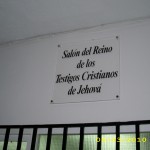Can you believe we’re already at Week 4 of Tiffany Dixon’s (M.Ed.-Languages) study abroad experience in Trujillo, Spain? This week, she uses her undergraduate training in political science and Spanish to paint a vivid picture of the dramatic cultural shifts taking place in Spain, and she visits the stunningly beautiful city of Lisbon on her free weekend. If you haven’t done so already, catch up with her adventures, and then continue reading below:
As I continued my interviews, I found that what I had been learning in the classroom at home and abroad was indeed an accurate portrayal of Spain today. The religious and political trends between different groups of people that influence Spain’s modern day culture quickly became apparent. For example, while over 70 percent of Spaniards profess Catholicism as their religion, only 20 percent actually practice. This shift in religious affiliation from centuries past allows for more social changes to take place in the national politics of Spain than in many other developed nations, such as legalization of same-sex marriage in 2005.
Another shift in religious affiliation that demonstrates an important change in politics is the growth of other denominations of Christianity, such as the increase in the number of Jehovah’s Witnesses. I had the opportunity to interview a few members of the congregation in Trujillo and learned that this group’s practices are mostly identical to those of Jehovah’s Witnesses in the United States. This includes not participating in the country’s political system in any way, not even by voting. Their belief is that one should not participate in a system in which the leaders do not govern according to the Bible, which include the guidelines that Jehovah (God) has set forth in order for an individual to live a Christian life.
Another important political trend was that, generally, people living in rural areas were less educated about national politics. It appeared to me that the general public is dissatisfied with the current Spanish Socialist Workers Party (Partido Socialista Obrero Español-PSOE) under Prime Minister José Luis Rodriguez Zapatero, but people living in the countryside, who were mostly farm workers, were not able to tell me why they were not in favor of the current government. People living in the cities named the price of buying a home, unemployment, and the unavailability of social security for retired persons, among many other reasons, for their political frustrations. All of these issues were covered in my research paper, which made for a very enriching learning experience.
At the end of the fourth week, we had a free weekend to travel. A few students chose Amsterdam and London for their weekend destination, while the majority of students, including me, chose Lisbon, Portugal. Lisbon, or Lisboa as both the Portuguese and Spanish call it, was by far the most beautiful city we visited.
The streets, statues, and buildings were a white that seemed to shimmer in the sun. Many shops lined the main streets, one of which lead to a beautiful view of the ocean. I went to Portugal with one of the other students on the trip that I became good friends with and her host family. Her host parents were only a few years older than me and were originally from Galicia, an autonomous region (remember, this is like a state in the US) in northern Spain in which gallego or Galician is spoken. Gallego, one of the official languages of Galicia, is a mix between Portuguese and Spanish. Thus, my friend’s host parents and the Portuguese were able to understand each other very easily as they spoke their respective languages. Our first night there we all went to the Hard Rock Café, where my friend and I felt very much at home. We had a wonderful time and danced all night to a lot of American music like the Jackson 5, Tina Turner, Prince, and newer artists such as The Black Eyed Peas. The next day we visited a cathedral, went shopping, took the metro, and rode up to another level of the city on the Santa Justa Lift said to be designed by the same architect, Gustave Eiffel, that designed the Eiffel tower in Paris.
While in Portugal, we enjoyed a very popular dish called mariscos con arroz (seafood and rice) which was very similar to paella but more of a soup flavored with cilantro. It was absolutely delicious!! On our last day we went to the beach at the Costa de Caparica beach and enjoyed the Atlantic Ocean. So it’s safe to say that I have now dipped my toes in the Mediterranean Sea in Spain, and both sides of the Atlantic Ocean in Charleston and now Portugal!!!
<Part 3 | Part 5>











[…] This post was mentioned on Twitter by C of C Grad School, Amy McCandless. Amy McCandless said: RT @GradSchool: Tiffany Dixon's (M.Ed. Lang.) travel journal continues: Spanish politics & the other side of the Atlantic http://is.gd/dKvUK […]